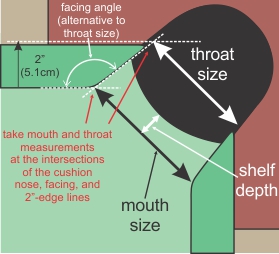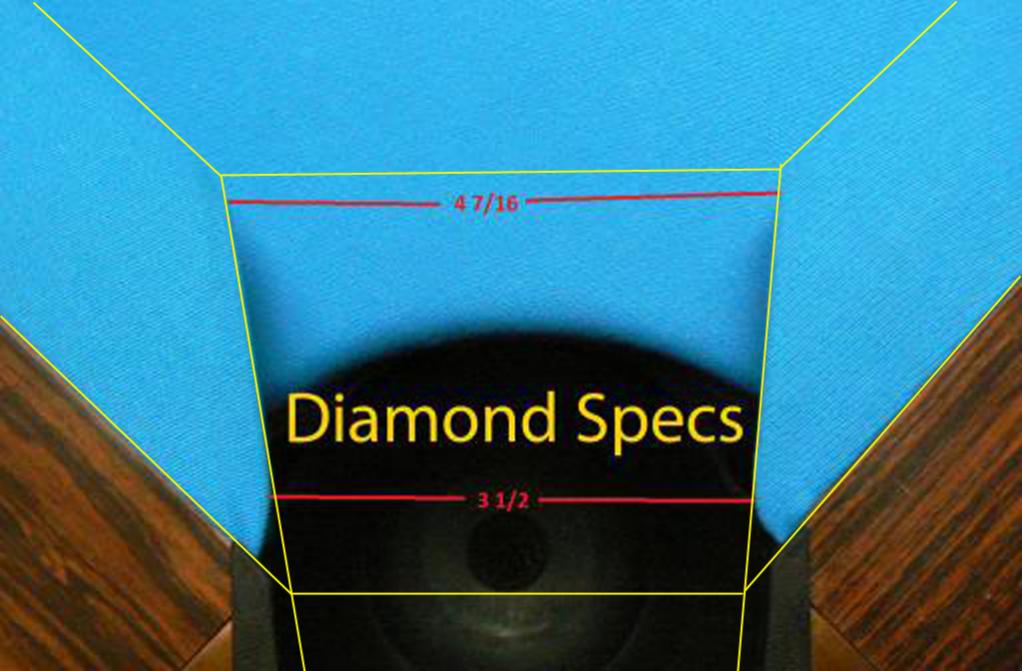Is there a way to measure and quatify how difficult a table plays?
The Table Difficulty Factor (TDF) system provides a very easy system to measure how “tough” a table plays. It is based on table size and the three corner-pocket measurements illustrated below. Four factors are used to account for table size, pocket size, pocket wall angle, and pocket shelf depth. Each factor is a number less than, equal to, or greater than 1, where 1 indicates average or standard. By multiplying the four factors, you get the TDF which is a good measure of table “toughness.” If TDF=1, the table has an average level of difficulty; if TDF>1, the table plays more difficult than average; and if TDF<1, the table plays easier than average.

See the Table Difficulty Factor (TDF) document to see how values for the following four factors are assigned:
- TSF: table size factor
- PSF: pocket size factor
- PAF: pocket angle factor
- PLF: pocket shelf factor
The total Table Difficulty Factor (TDF) is calculated by multiplying the four factors:
TDF = TSF x PSF x PAF x PLF
The TDF can also be calculated automatically from table and pocket measurements using the Excel TDF calculator spreadsheet (authored by Adam Bishop) or the mobile-friendly online tool (authored by “Isaac” on AZB). Example TDF ratings for a wide range of table sizes, types, and brands can be found in the AZB TDF thread.
The TDF can be used to adjust numbers from any scoring or rating system like the Billiard University Exams, “playing the ghost” drills, Hopkins Q Skills drill, or the Fargo rating drill or the FargoRate handicapping system. An effective score, taking table difficulty into consideration, can be calculated with:
(effective score) = (raw score) x TDF
See the TDF document for details and examples. And For more information, see: “Billiard University (BU) – Part IV: Table Difficulty” (BD, November, 2013). And for lots of examples for a wide range of tables, see the AZB TDF thread.
How were the values and ranges chosen for each of the TDF factors?
All of the values and ranges for the individual TDF factors (TSF, PSF, PAF, PLF) were chosen very carefully based on how each factor affects the margin of error for a wide range of shots. In particular, the analyses and data in TP 3.4 – Margin of error based on distance and cut angle, TP 3.6 – Effective target sizes for slow shots into a corner pocket at different angles, and pocket “size” and “center” resource page were good starting points. However, adjustments were made based on anecdotal and empirical evidence for how tough a wide range of tables actual play. Many people provided input to guide these changes. Quite a few AZB users provided valuable input and feedback on the TDF thread; and Mark Finkelstein, Mike Page, and Bob Jewett were particularly helpful in sharing their experience and judgement. Some of the factors that helped guide the adjustments include:
- On a smaller table, shot distances are generally shorter, and everything is easy to reach without a mechanical bridge; but on a larger table, there is less “traffic” with position play and balls are less likely to cluster.
- Pocket size is the most important attribute affecting pocket difficulty.
- When the pockets are very small, further tightening has a much bigger effect since the precision required will be pushing the limits for even the best players. And for big pockets, an increase might have very little effect for most shots where the precision required is well within the limits for even a mediocre player.
- For many shots, especially with a better player, a significant portion of the pocket margin is available for pocket cheating. In other words, many balls can be easily pocketed, and making the pocket smaller does more to limit pocket cheating than cause misses.
- For people who are not very accurate shot makers, both table size and pocket size make a huge difference, especially on bigger tables with “tighter” pockets. For accurate shot makers, a table size increase does not increase overall difficulty very much, especially if the pockets are not very “tight.”
- Pocket facing-angles and shelf depth are more important with smaller pockets (where the pocket points will be hit more often).
- Shelf depth isn’t as important as pocket size and facing angle, but it definitely has an effect.
For more rationale and justification, see “Billiard University (BU) – Part IV: Table Difficulty” (BD, November, 2013).
Is it better to practice on a table with tight pockets?
Practicing on a table with tight pockets is good for working on your focus and shot-making. But, it is best to practice on the equipment that you play on most often in competition, so you can focus on your whole game, and not just shot-making.
When you plan on a table with tight pockets, it forces you to:
- focus more and be more accurate.
- use sidespin less and keep things simple.
- make sure you don’t hit the near point of the pocket and instead target the far facing.
But playing on difficult equipment forces you to play more conservatively and you won’t be practicing the types of shots and strategies you might use on more-forgiving equipment. If you don’t practice these things, you won’t be as effective with them when they are called for.
Doesn’t side pocket geometry and other factors like cloth and cushion conditions also affect a table’s toughness?
Yes. Many other factors (side pocket geometry, facing bevel or downward angle, cloth type and condition, cloth tightness and age, cloth cleanliness, ball conditions and cleanliness, pocket facing and shim properties, rail and cushion conditions, table levelness, temperature, humidity, etc.) play a role, but the three corner pocket measurements are the most important factors determining how tough a table plays over a wide range of conditions. Also, we wanted to keep the TDF system as simple as possible to use with as few measurements as possible, while still providing useful info.
When the TDF system was developed, side pocket measurements were excluded to keep the system as simple as possible (requiring as few measurements as possible) while still capturing the most important characteristics of a table. On most tables, it is the corner pocket toughness (and not the side pocket toughness) that dominates overall table difficulty level.
For a comparison of the effects of side pocket and corner pocket difficulty effects, see the effective pocket size resource page.
The best way to characterize cloth speed is with a stimpmeter test.
The best way to characterize cushions is with standard kick/bank systems tests.
How was the “standard” table measurements decided?
The measurements are mostly based on the centers of the WPA table specification ranges (see Section 9). But changes were made based on recent trends and input from table mechanics. Regardless, the chosen values aren’t really that important, and what is considered “standard” has changed over the years (and will probably continue to change). What is important is the relative comparison between tables, which the TDF system provides. The rationale used to create the number ranges and values in the TDF tables (which control relative comparisons) is summarized above.
from realkingcobra in AZB post:
Facings play a major role in rejecting balls from pockets as do cushions. Take the Olhausen tables for example. The cushions are very, very soft, the facings are 1/8″ and very soft. What happens on an Olhausen table is that when you’re attempting to pocket a ball in the corner pocket coming down the rails, you’re shooting the ball right into the outer have of the pocket facing with no rail wood support behind the cushion. When you do this, what happens is that when the ball being pocketed hits the facing, instead of deflecting to-wards the back of the pocket, it compresses the facing and cushion kind of like creating a flat spot at the end of the cushion, which in turn kicks the ball across the pocket to the opposite facing and back out again, and you don’t even have to shoot the shot hard to get this “rejection” to happen. So, now comes in the role of the facings. If the soft 1/8″ facings are replaced with harder 3/16″ neoprene facings, these facings don’t compress nearly as much when you shoot a ball into them, so the balls that would normally reject … go in because they deflect off the facings deeper into the back of the pocket.
from Sloppy Pockets in AZB post, concerning how to properly measure the pocket mouth and throat dimensions (at the intersections of the yellow lines, not at the labeled red dimensions):

from iusedtoberich AZB post:
Perhaps something like laying post it notes stuck on the cushion can extend the lines of the cushion to a real intersection point, that can then be measured to and from.
Dr. Dave keeps this site commercial free, with no ads. If you appreciate the free resources, please consider making a one-time or monthly donation to show your support:
